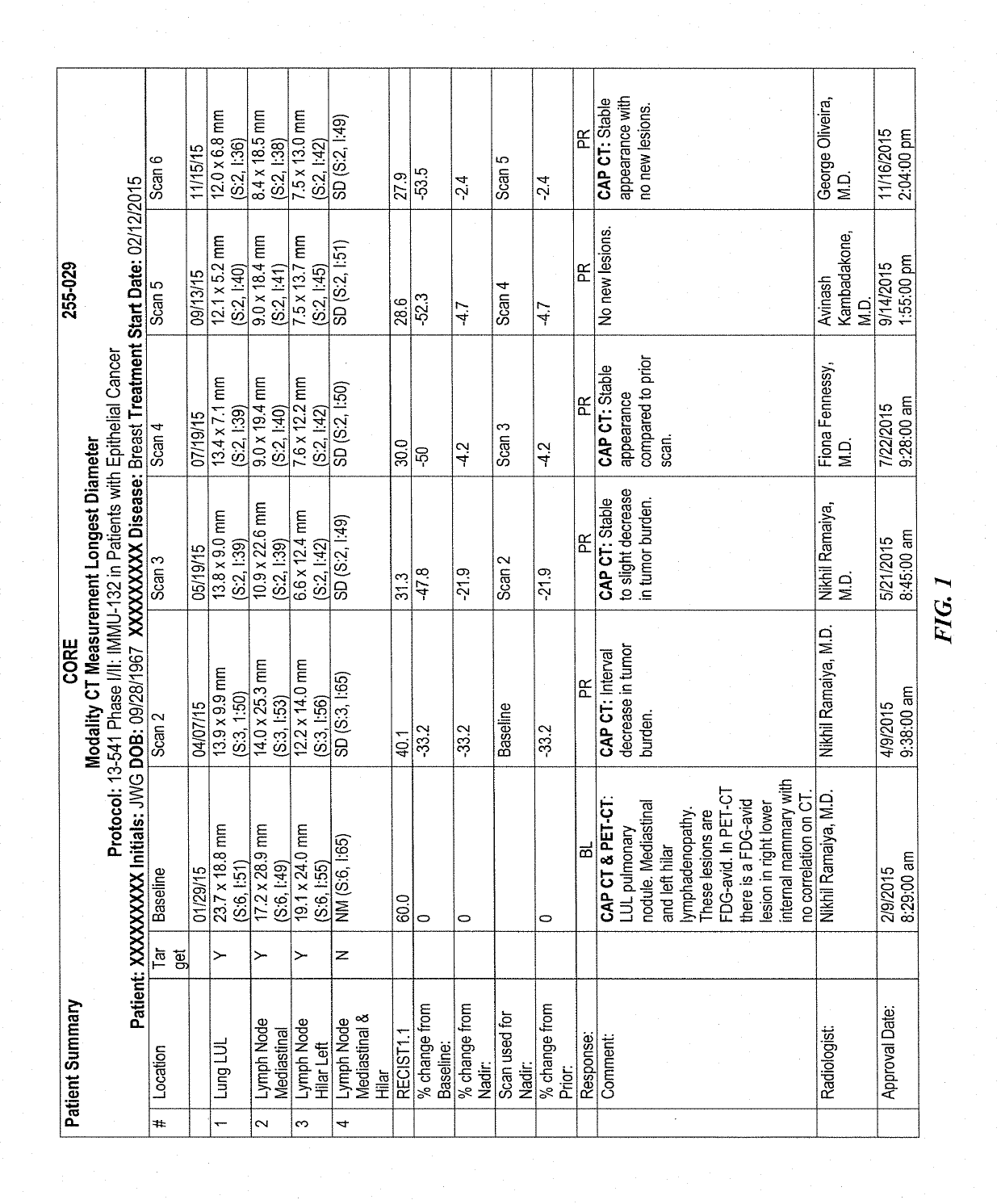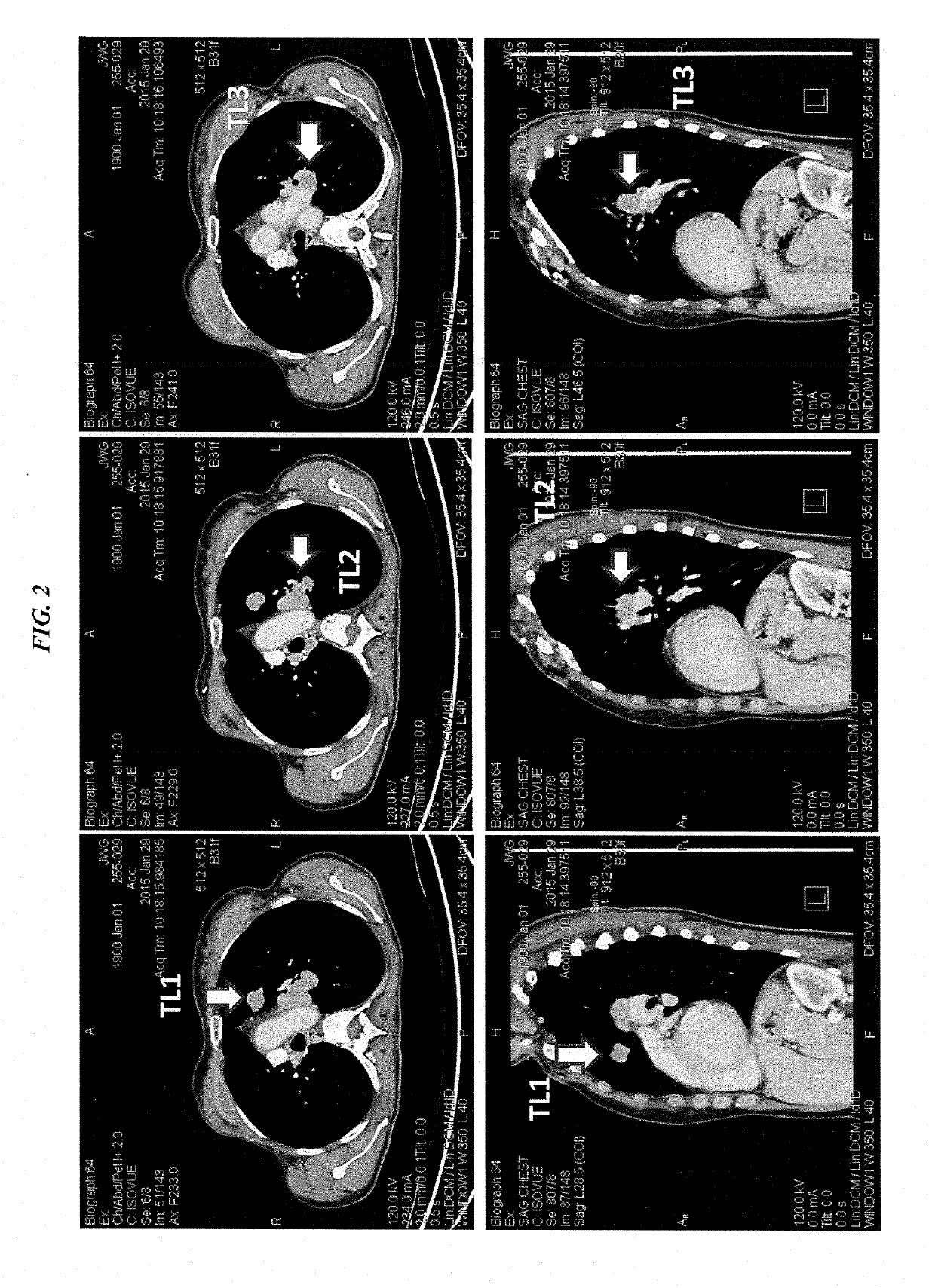Efficacy of anti-trop-2-SN-38 antibody drug conjugates for therapy of tumors relapsed/refractory to checkpoint inhibitors
a technology of anti-trop-2 sn-38 and antibody conjugates, which is applied in the direction of immunoglobulins against animals/humans, drug compositions, sexual disorders, etc., can solve the problems of insufficient utility of trop-2 expression testing in archived samples of 16 patients with diverse cancers to allow for a definitive assessment, and the treatment was terminated. , to achieve the effect of improving targeting, enhancing the delivery of the therapeutic agent, and reducing the number of patients
- Summary
- Abstract
- Description
- Claims
- Application Information
AI Technical Summary
Benefits of technology
Problems solved by technology
Method used
Image
Examples
example 1
n and Use of Anti-Trop-2-SN-38 Antibody-Drug Conjugate
[0223]The humanized RS7 (hRS7) anti-Trop-2 antibody was produced as described in U.S. Pat. No. 7,238,785, the Figures and Examples section of which are incorporated herein by reference. SN-38 attached to a CL2A linker was produced and conjugated to hRS7 (anti-Trop-2), hPAM4 (anti-MUC5ac), hA20 (anti-CD20) or hMN-14 (anti-CEACAM5) antibodies according to U.S. Pat. No. 7,999,083 (Example 10 and 12 of which are incorporated herein by reference). The conjugation protocol resulted in a ratio of about 6 SN-38 molecules attached per antibody molecule.
[0224]Immune-compromised athymic nude mice (female), bearing subcutaneous human pancreatic or colon tumor xenografts were treated with either specific CL2A-SN-38 conjugate or control conjugate or were left untreated. The therapeutic efficacies of the specific conjugates were observed. In a Capan 1 pancreatic tumor model, specific CL2A-SN-38 conjugates of hRS7 (anti-Trop-2), hPAM4 (anti-MUC-...
example 2
ic Use of Anti-Trop-2 ADC (Sacituzumab Govitecan) in Patients Refractory to Checkpoint Inhibitor Therapy
[0225]Summary
[0226]IMMU-132 (sacituzumab govitecan, aka hRS7-CL2A-SN-38) has shown promising therapeutic results in phase II trials of patients with metastatic triple-negative breast and other cancers who were heavily pretreated (ClinicalTrials.gov, NCT01631552), and who express high levels of Trop-2. This novel Trop-2-targeting humanized antibody is conjugated with 7.6 moles of SN-38, the active form of irinotecan, by the CL2A linker discussed above, and is less glucuronidated in vivo than irinotecan, accounting for a significantly lower incidence of diarrhea in patients treated with the agent.
[0227]Surprisingly, IMMU-132 is highly efficacious in patients who have previously relapsed from or shown resistance to many standard anti-cancer therapies, including the parent compound irinotecan. A new class of anti-cancer agents, known as checkpoint inhibitors, include antibodies or oth...
example 3
vity of Anti-Trop-2 ADCs
[0246]The ADCC activity of various hRS7-ADC conjugates was determined in comparison to hRS7 IgG (not shown). PBMCs were purified from blood purchased from the Blood Center of New Jersey. A Trop-2-positive human pancreatic adenocarcinoma cell line (BxPC-3) was used as the target cell line with an effector to target ratio of 100:1. ADCC mediated by hRS7 IgG was compared to hRS7-Pro-2-PDox, hRS7-CL2A-SN-38, and the reduced and capped hRS7-NEM. All were used at 33.3 nM.
[0247]Overall activity was low, but significant (not shown). There was 8.5% specific lysis for the hRS7 IgG which was not significantly different from hRS7-Pro-2-PDox. Both were significantly better than hLL2 control and hRS7-NEM and sacituzumab govitecan (P<0.02, two-tailed t-test). There was no difference between hRS7-NEM and sacituzumab govitecan.
PUM
| Property | Measurement | Unit |
|---|---|---|
| pH | aaaaa | aaaaa |
| pH | aaaaa | aaaaa |
| volume | aaaaa | aaaaa |
Abstract
Description
Claims
Application Information
 Login to View More
Login to View More - R&D
- Intellectual Property
- Life Sciences
- Materials
- Tech Scout
- Unparalleled Data Quality
- Higher Quality Content
- 60% Fewer Hallucinations
Browse by: Latest US Patents, China's latest patents, Technical Efficacy Thesaurus, Application Domain, Technology Topic, Popular Technical Reports.
© 2025 PatSnap. All rights reserved.Legal|Privacy policy|Modern Slavery Act Transparency Statement|Sitemap|About US| Contact US: help@patsnap.com



